brake TOYOTA YARIS 2013 Owners Manual
[x] Cancel search | Manufacturer: TOYOTA, Model Year: 2013, Model line: YARIS, Model: TOYOTA YARIS 2013Pages: 712, PDF Size: 30.2 MB
Page 3 of 712
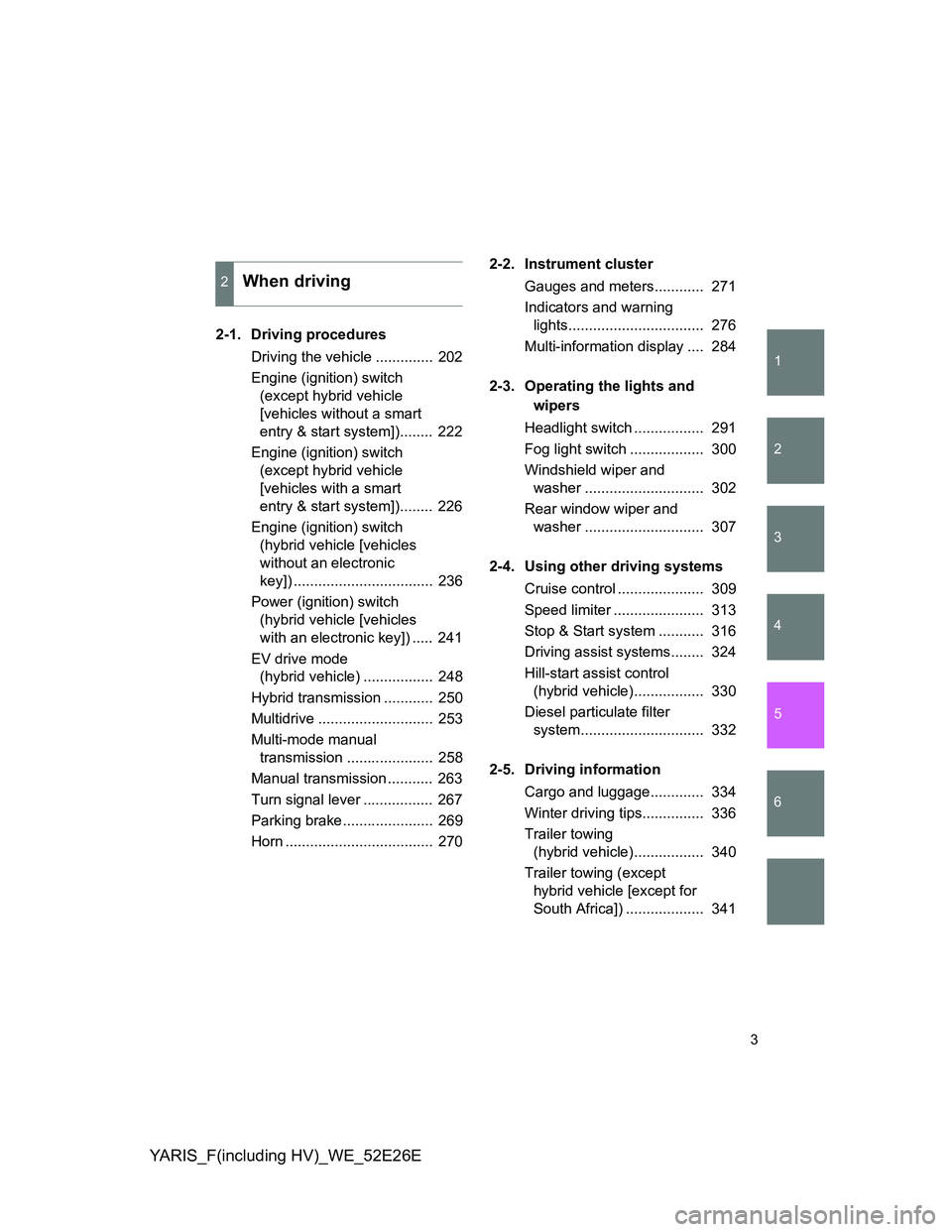
1
2
3
4
5
6
YARIS_F(including HV)_WE_52E26E
3
2-1. Driving procedures
Driving the vehicle .............. 202
Engine (ignition) switch
(except hybrid vehicle
[vehicles without a smart
entry & start system])........ 222
Engine (ignition) switch
(except hybrid vehicle
[vehicles with a smart
entry & start system])........ 226
Engine (ignition) switch
(hybrid vehicle [vehicles
without an electronic
key]) .................................. 236
Power (ignition) switch
(hybrid vehicle [vehicles
with an electronic key]) ..... 241
EV drive mode
(hybrid vehicle) ................. 248
Hybrid transmission ............ 250
Multidrive ............................ 253
Multi-mode manual
transmission ..................... 258
Manual transmission ........... 263
Turn signal lever ................. 267
Parking brake...................... 269
Horn .................................... 2702-2. Instrument cluster
Gauges and meters............ 271
Indicators and warning
lights................................. 276
Multi-information display .... 284
2-3. Operating the lights and
wipers
Headlight switch ................. 291
Fog light switch .................. 300
Windshield wiper and
washer ............................. 302
Rear window wiper and
washer ............................. 307
2-4. Using other driving systems
Cruise control ..................... 309
Speed limiter ...................... 313
Stop & Start system ........... 316
Driving assist systems........ 324
Hill-start assist control
(hybrid vehicle)................. 330
Diesel particulate filter
system.............................. 332
2-5. Driving information
Cargo and luggage............. 334
Winter driving tips............... 336
Trailer towing
(hybrid vehicle)................. 340
Trailer towing (except
hybrid vehicle [except for
South Africa]) ................... 341
2When driving
Page 18 of 712
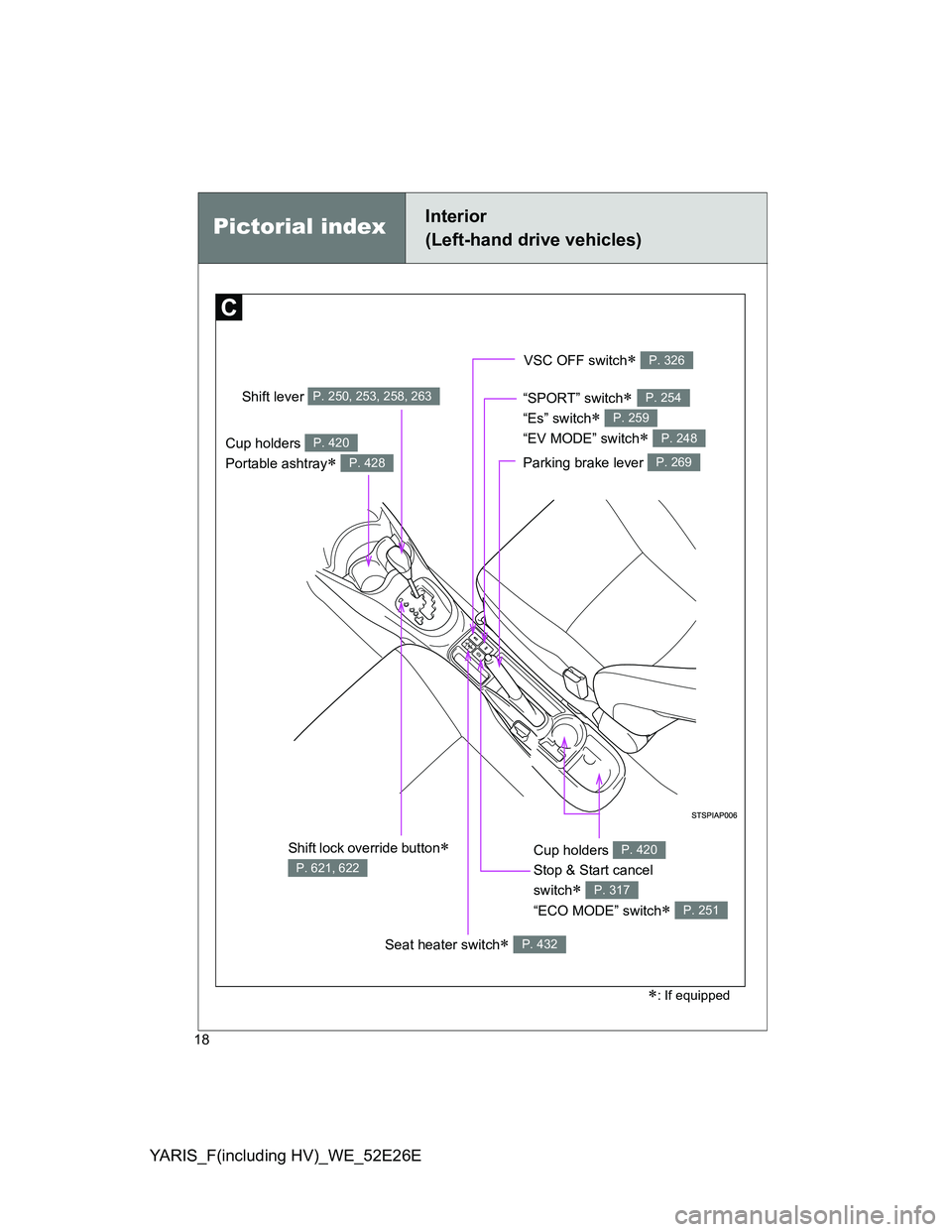
YARIS_F(including HV)_WE_52E26E
18
VSC OFF switch P. 326
“SPORT” switch
“Es” switch
“EV MODE” switch
P. 254
P. 259
P. 248Cup holders
Portable ashtray
P. 420
P. 428
Shift lever P. 250, 253, 258, 263
Parking brake lever P. 269
Cup holders P. 420
Stop & Start cancel
switch
“ECO MODE” switch
P. 317
P. 251
Seat heater switch P. 432
Shift lock override button
P. 621, 622
: If equipped
Pictorial indexInterior
(Left-hand drive vehicles)
Page 30 of 712
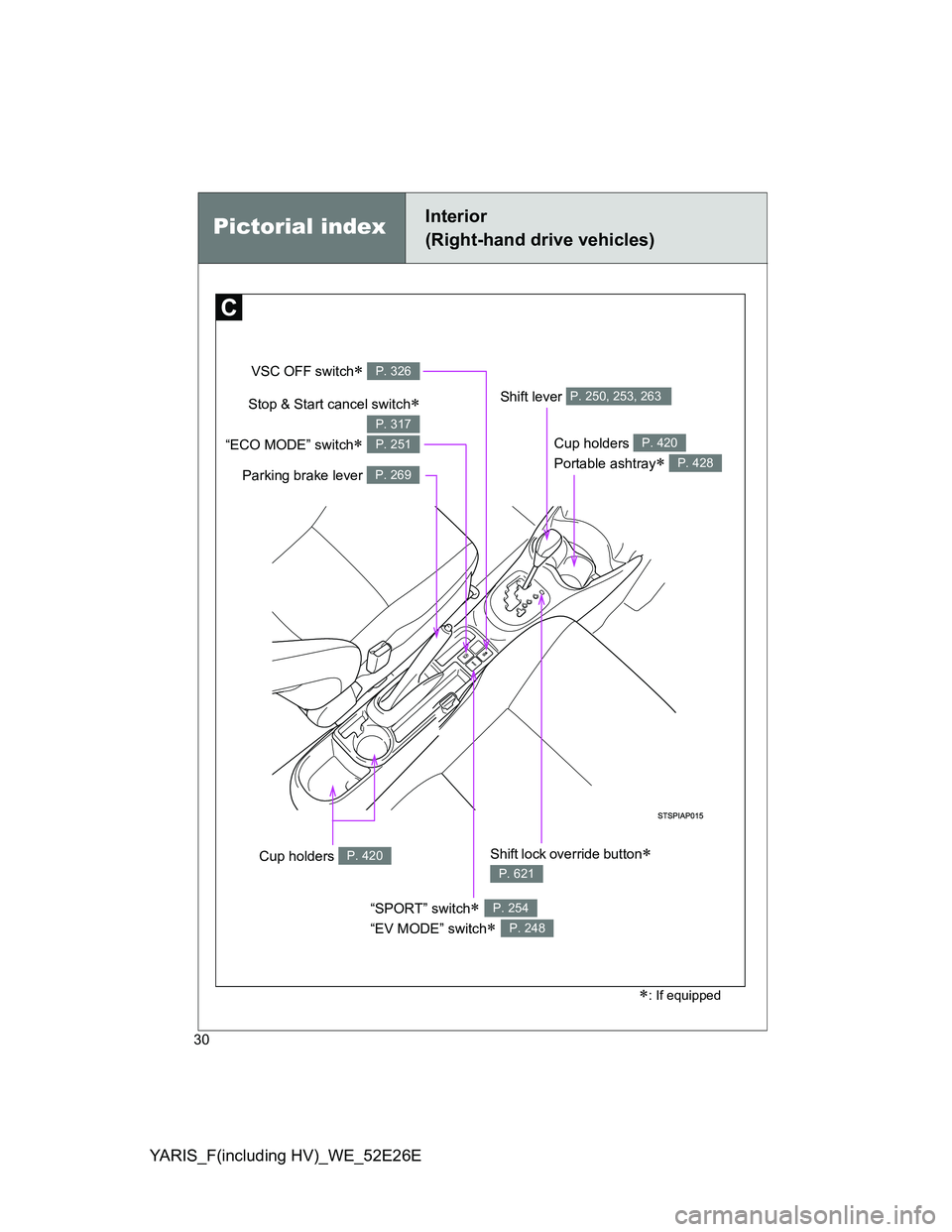
YARIS_F(including HV)_WE_52E26E
30
: If equipped
VSC OFF switch P. 326
Cup holders
Portable ashtray
P. 420
P. 428
Shift lever P. 250, 253, 263
Parking brake lever P. 269
Cup holders P. 420
Stop & Start cancel switch
“ECO MODE” switch
P. 317
P. 251
Shift lock override button
P. 621
“SPORT” switch
“EV MODE” switch
P. 254
P. 248
Pictorial indexInterior
(Right-hand drive vehicles)
Page 39 of 712
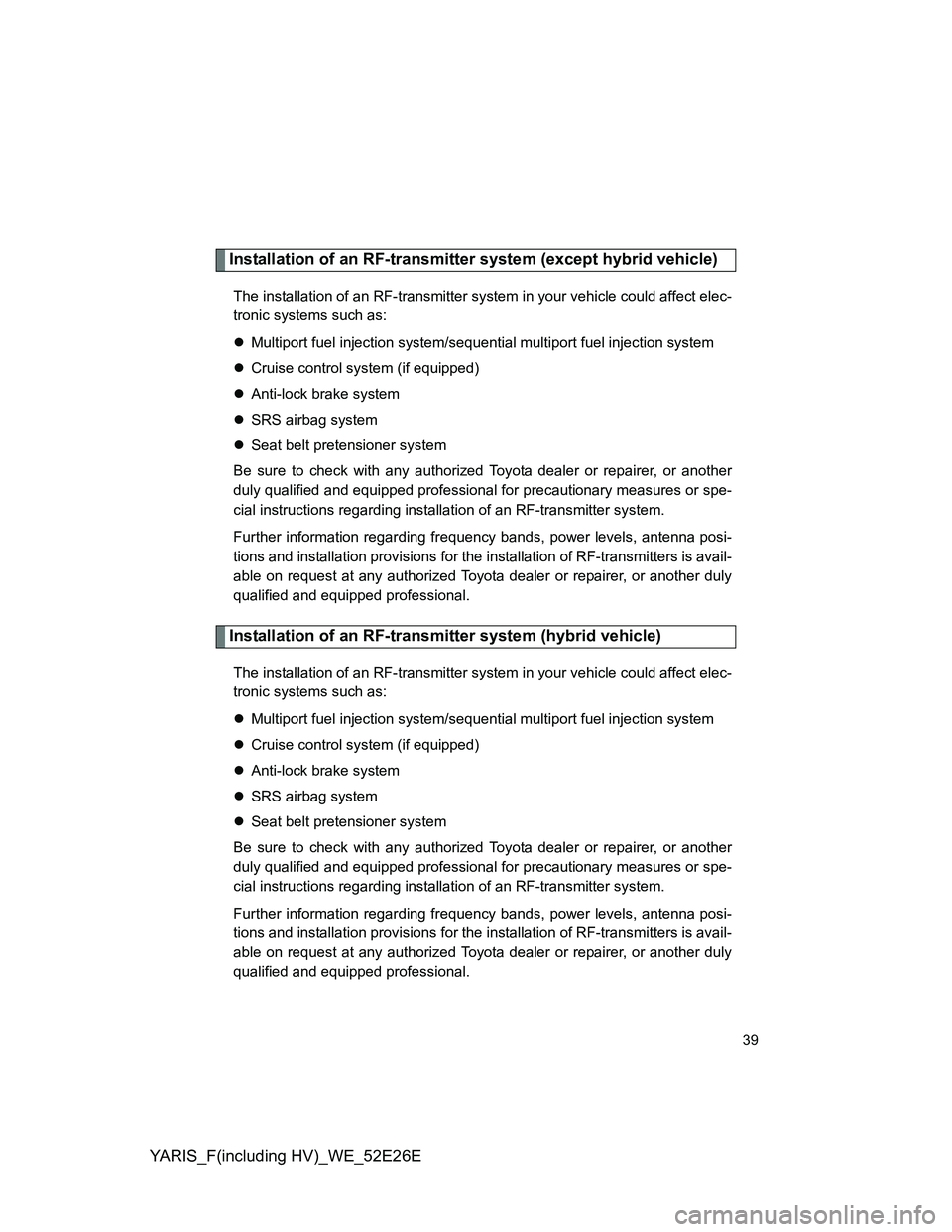
YARIS_F(including HV)_WE_52E26E
39
Installation of an RF-transmitter system (except hybrid vehicle)
The installation of an RF-transmitter system in your vehicle could affect elec-
tronic systems such as:
Multiport fuel injection system/sequential multiport fuel injection system
Cruise control system (if equipped)
Anti-lock brake system
SRS airbag system
Seat belt pretensioner system
Be sure to check with any authorized Toyota dealer or repairer, or another
duly qualified and equipped professional for precautionary measures or spe-
cial instructions regarding installation of an RF-transmitter system.
Further information regarding frequency bands, power levels, antenna posi-
tions and installation provisions for the installation of RF-transmitters is avail-
able on request at any authorized Toyota dealer or repairer, or another duly
qualified and equipped professional.
Installation of an RF-transmitter system (hybrid vehicle)
The installation of an RF-transmitter system in your vehicle could affect elec-
tronic systems such as:
Multiport fuel injection system/sequential multiport fuel injection system
Cruise control system (if equipped)
Anti-lock brake system
SRS airbag system
Seat belt pretensioner system
Be sure to check with any authorized Toyota dealer or repairer, or another
duly qualified and equipped professional for precautionary measures or spe-
cial instructions regarding installation of an RF-transmitter system.
Further information regarding frequency bands, power levels, antenna posi-
tions and installation provisions for the installation of RF-transmitters is avail-
able on request at any authorized Toyota dealer or repairer, or another duly
qualified and equipped professional.
Page 40 of 712

YARIS_F(including HV)_WE_52E26E
40
High voltage parts and cables on the hybrid vehicles emit approximately the
same amount of electromagnetic waves as the conventional gasoline pow-
ered vehicles or home electronic appliances despite of their electromagnetic
shielding.
Unwanted noise may occur in the reception of the RF-transmitter.
Vehicle data recordings
Your Toyota is equipped with several sophisticated computers that will record
certain data, such as:
• Engine speed
• Electric motor speed (traction motor speed)
• Accelerator status
• Brake status
• Vehicle speed
• Shift position (except manual transmission)
• Hybrid battery (traction battery) status
The recorded data varies according to the vehicle grade level and options
with which it is equipped. Furthermore, these computers do not record con-
versations, sounds or pictures.
Data usage
Toyota may use the data recorded in these computers to diagnose malfunc-
tions, conduct research and development, and improve quality.
Toyota will not disclose the recorded data to a third party except:
• With the consent of the vehicle owner or with the consent of the lessee if
the vehicle is leased
• In response to an official request by the police, a court of law or a govern-
ment agency
• For research purposes where the data is not tied to a specific vehicle or
vehicle owner
: If equipped
Page 41 of 712

YARIS_F(including HV)_WE_52E26E
41
Event data recorder
This vehicle is equipped with an event data recorder (EDR). The main pur-
pose of an EDR is to record, in certain crash or near crash-like situations,
such as an air bag deployment or hitting a road obstacle, data that will assist
in understanding how a vehicle’s systems performed. The EDR is designed
to record data related to vehicle dynamics and safety systems for a short
period of time, typically 30 seconds or less.
The EDR in this vehicle is designed to record such data as:
• How various systems in your vehicle were operating;
• How far (if at all) the driver was depressing the accelerator and/or brake
pedal; and,
• How fast the vehicle was traveling.
These data can help provide a better understanding of the circumstances in
which crashes and injuries occur.
NOTE: EDR data are recorded by your vehicle only if a non-trivial crash situ-
ation occurs; no data are recorded by the EDR under normal driving condi-
tions and no personal data (e.g., name, gender, age, and crash location) are
recorded. However, other parties, such as law enforcement, could combine
the EDR data with the type of personally identifying data routinely acquired
during a crash investigation.
To read data recorded by an EDR, special equipment is required, and access
to the vehicle or the EDR is needed. In addition to the vehicle manufacturer,
other parties, such as law enforcement, that have the special equipment, can
read the information if they have access to the vehicle or the EDR.
Disclosure of the EDR data
Toyota will not disclose the data recorded in an EDR to a third party except
when:
• An agreement from the vehicle’s owner (or the lessee for a leased vehicle)
is obtained
• In response to an official request by the police, a court of law or a govern-
ment agency
• For use by Toyota in a law suit
However, if necessary, Toyota may:
• Use the data for research on vehicle safety performance
• Disclose the data to a third party for research purposes without disclosing
information about the specific vehicle or vehicle owner
Page 49 of 712

49 1-1. Hybrid system (hybrid vehicle)
1
Before driving
YARIS_F(including HV)_WE_52E26E
Regenerative braking
In the following situations, kinetic energy is converted to electric energy and
deceleration force can be obtained in conjunction with the recharging of the
hybrid battery (traction battery).
The accelerator pedal is released.
The brake pedal is depressed with the shift lever in D or B.
When stopped/during start off
The gasoline engine stops
* when the vehicle is stopped. During
start off, the electric motor (traction motor) drives the vehicle. At
slow speeds or when traveling down a gentle slope, the engine
is stopped
* and the motor is used.
*: However, when the hybrid battery (traction battery) needs to be
charged or while the engine is being warmed up, the gasoline engine
may not stop automatically. (P. 50)
During normal driving
The gasoline engine is predominantly used. The electric motor
(traction motor) charges the hybrid battery (traction battery) as
necessary.
When accelerating sharply
The power of the hybrid battery (traction battery) is added to that
of the gasoline engine via the electric motor (traction motor).
When braking (regenerative braking)
The electric motor (traction motor) charges the hybrid battery
(traction battery).
Page 51 of 712
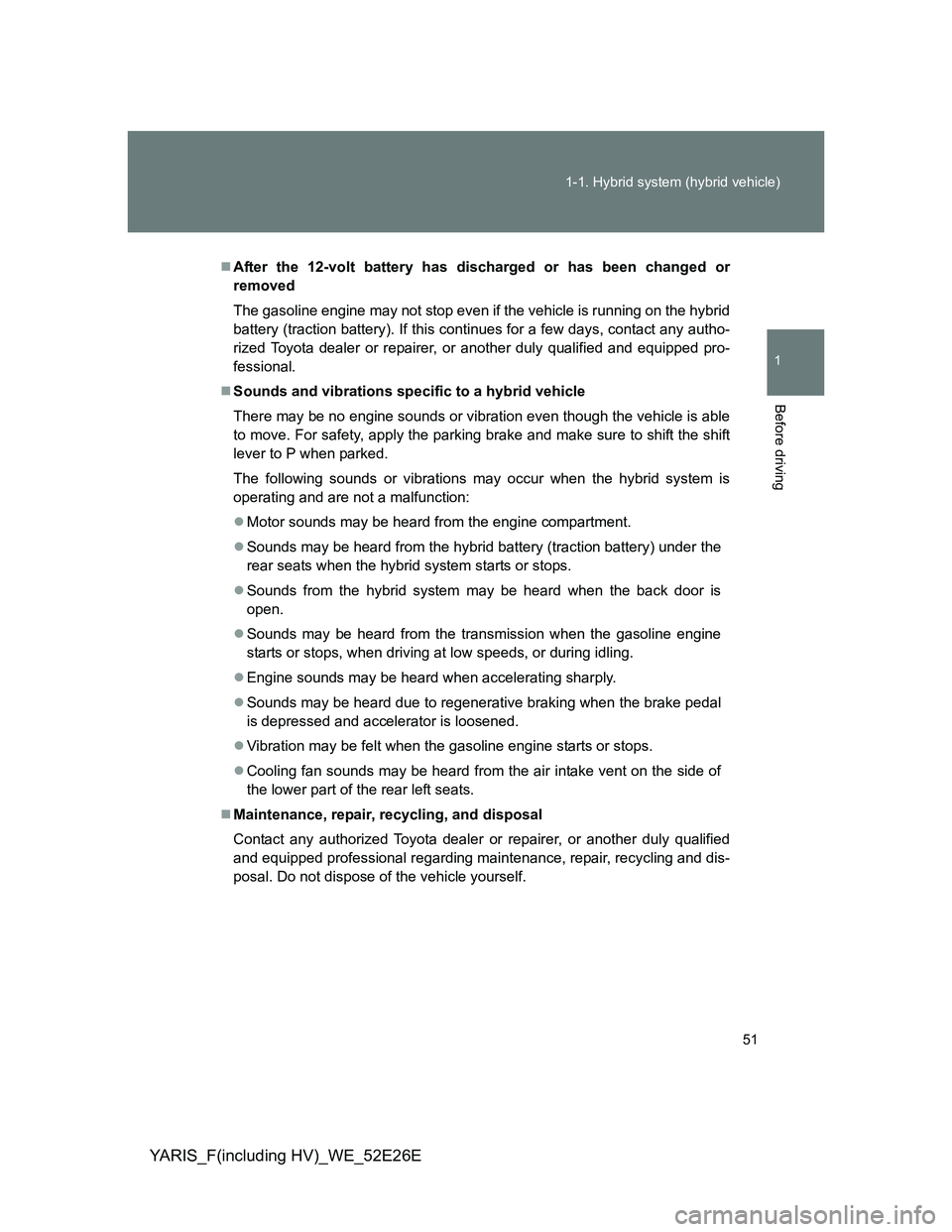
51 1-1. Hybrid system (hybrid vehicle)
1
Before driving
YARIS_F(including HV)_WE_52E26E
After the 12-volt battery has discharged or has been changed or
removed
The gasoline engine may not stop even if the vehicle is running on the hybrid
battery (traction battery). If this continues for a few days, contact any autho-
rized Toyota dealer or repairer, or another duly qualified and equipped pro-
fessional.
Sounds and vibrations specific to a hybrid vehicle
There may be no engine sounds or vibration even though the vehicle is able
to move. For safety, apply the parking brake and make sure to shift the shift
lever to P when parked.
The following sounds or vibrations may occur when the hybrid system is
operating and are not a malfunction:
Motor sounds may be heard from the engine compartment.
Sounds may be heard from the hybrid battery (traction battery) under the
rear seats when the hybrid system starts or stops.
Sounds from the hybrid system may be heard when the back door is
open.
Sounds may be heard from the transmission when the gasoline engine
starts or stops, when driving at low speeds, or during idling.
Engine sounds may be heard when accelerating sharply.
Sounds may be heard due to regenerative braking when the brake pedal
is depressed and accelerator is loosened.
Vibration may be felt when the gasoline engine starts or stops.
Cooling fan sounds may be heard from the air intake vent on the side of
the lower part of the rear left seats.
Maintenance, repair, recycling, and disposal
Contact any authorized Toyota dealer or repairer, or another duly qualified
and equipped professional regarding maintenance, repair, recycling and dis-
posal. Do not dispose of the vehicle yourself.
Page 55 of 712

55 1-1. Hybrid system (hybrid vehicle)
1
Before driving
YARIS_F(including HV)_WE_52E26E
CAUTION
Road accident cautions
If your vehicle is involved in an accident, observe the following precautions
to reduce the risk of death or serious injury:
Stop the vehicle in a safe place to prevent subsequent accidents, shift the
shift lever to P, apply the parking brake, and turn the hybrid system off.
(P. 237, 242)
Do not touch the high voltage parts, cables or connectors.
If electric wires are exposed inside or outside your vehicle, an electric
shock may occur. Never touch exposed electric wires.
If a fluid leak occurs, do not touch the fluid as it may be strong alkaline
electrolyte from the hybrid battery (traction battery). If it comes into contact
with your skin or eyes, wash it off immediately with a large amount of water
or, if possible, boric acid solution. Seek immediate medical attention.
If a fire occurs in the hybrid vehicle, leave the vehicle as soon as possible.
Never use a fire extinguisher that is not meant for electric fires. Using even
a small amount of water may be dangerous.
If your vehicle needs to be towed, do so with front wheels raised. If the
wheels connected to the electric motor (traction motor) are on the ground
when towing, the motor may continue to generate electricity. This may
cause an electricity leakage leading to a fire. (P. 549)
Carefully inspect the ground under the vehicle. If you find that liquid has
leaked onto the ground, the fuel system may have been damaged. Leave
the vehicle as soon as possible and contact any authorized Toyota dealer
or repairer, or another duly qualified and equipped professional.
Nickel-metal hydride battery
Your vehicle contains a sealed nickel-metal hydride battery. If disposed of
improperly, it is hazardous to the environment and there is a risk of severe
burns and electrical shock that may result in death or serious injury.
Page 62 of 712

62
1-1. Hybrid system (hybrid vehicle)
YARIS_F(including HV)_WE_52E26E
Hybrid vehicle driving tips
For economical and ecological driving, pay attention to the following
points:
Using Eco drive mode
P. 251
Use of Hybrid System Indicator
Eco-friendly driving is possible by keeping the indicator needle of
Hybrid System Indicator within Eco area. (P. 274)
When braking the vehicle
Make sure to operate the brakes gently and in good time. A greater
amount of electrical energy can be retained when slowing down.
Delays
Repeated acceleration and deceleration, as well as long waits at traffic
lights, will lead to bad fuel consumption. Check traffic reports before
leaving and avoid delays as much as possible. When encountering a
delay, gently release the brake pedal to allow the vehicle to move for-
ward slightly while avoiding overuse of the accelerator pedal. Doing so
can help control excessive gasoline consumption.
Highway driving
Control your speed and keep at a constant speed. Also, before stop-
ping at a toll booth or similar, allow plenty of time to release the acceler-
ator and gently apply the brakes. A greater amount of electrical energy
can be retained when slowing down.
Air conditioning
Use the air conditioning only when necessary. Doing so can help con-
trol excessive gasoline consumption.
In summer: In high temperatures, use the recirculated air mode. Doing
so will help to reduce the burden on the air conditioner and reduce fuel
consumption as well.
In winter: Because the gasoline engine will not automatically cut out
until the gasoline engine and the interior of the vehicle are warm, it will
consume fuel. Also, fuel consumption can be improved by avoiding
overuse of the heater such as setting the temperature too high.